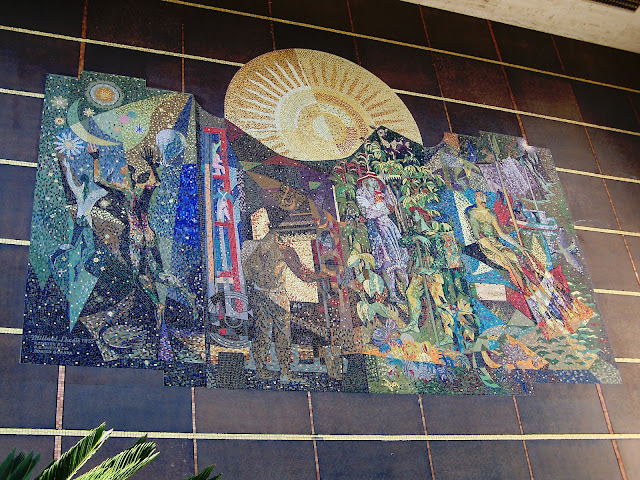Two stories for Mosaic Monday.
Actually, the first is so multifaceted it's way more than one part.
LA Curbed just ran a cycle of stories for Millard Sheets Week that includes:
Adam Arenson's map of Sheets' work throughout the area,
A photograph-intense post of the artist's former design studio in Claremont,
A tour of five big Sheets artworks in Los Angeles County--Chase banks in Beverly Hills (my own photo of that below), Studio City, and Rancho Palos Verdes, as well as the City Hall mural and the New Balance store in Santa Monica,
-
A special essay on the Hollywood Chase Bank (formerly Home S&L, of course, as are most Chase Banks mentioned),
The Claremont-Pomona tour, with incredible pictures of the Garrison Theatre (how did they do that? that place is impossible to photograph well!), the Chase Bank in Pomona and the Mall there, the US Bank on Foothill, and the mural in the American Museum of Ceramic Art,
Another photo-heavy presentation of the Scottish Rite Temple on Wilshire, which I've never featured on my blog because I could never figure out how to get into the place. Curbed LA managed to get dozens of stunning pictures.
Sheets did not work alone, and Curbed wrote up his collaborators, like Susan Hertel and Denis O'Connor, Arthur and Jean Ames, and other sculptors and architects.
An article on how Sheets raised funds and built up two academic art institutions: the complex at Scripps College, Otis Art Institute--and was briefly involved with a third, CalArts in Valencia.

So have at it--that will keep you busy through lunch time, at least. Curbed drew a lot from the oral history that Sheets did with UCLA--hours of talking, from the 1970s. It's transcribed online here.

Now for Part II:
Temecula is not in Los Angeles County, but we all go out there occasionally for a bit of history and to tour the wineries, right?
At the beginning of 2011, the city of Temecula unveiled a new mosaic by artist Carole Choucair Ouejian titled "The Emigrant Trail" at their big new City Hall.
The artist used blocks of rough, local granite to enhance and contrast with the the tile and Byzantine glass pictures of men and women with their covered wagon, at right.
The entire work--7 by 10 feet--includes a frame worked with gold smalti--appropriate, because gold is what drew most of those emigrants across the plains and desert to California. In the frame, there is a stagecoach--Temecula was once a stop on the Butterfield Stage Line--and other images that tell the story of the area.
A large, in-depth article with pictures of the artist's other mosaic work, is at Mosaic Art Now. You can see how the entire work was constructed, laid out, and assembled, as well as some of the exquisite details of the gold work. Below is one of many pictures there--I like it because it shows the tactile, sculptured aspects of the mosaic. The pictures of the finished work are beautiful too, of ocurse.


1 comment:
I enjoy reading write-up. Hope i can discover a lot more articles like this one. Thanks for posting.
Post a Comment